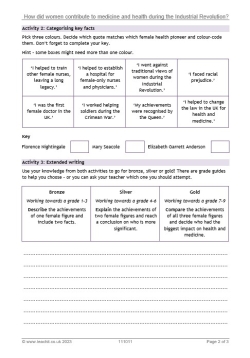How did women contribute to medicine and health during the Industrial Revolution?

This KS3 history worksheet features profiles of three significant women who contributed to health and medicine during the Industrial Revolution: Florence Nightingale, Mary Seacole and Elizabeth Garrett Anderson.
Students highlight the most important facts and then colour-code information about the three figures. Finally, they write a paragraph to describe, explain and/or compare the achievements of the three women.
Makes a great resource for International Women's Day on 8 March.
An extract from the information about Florence Nightingale:
In 1854 Florence volunteered to help injured soldiers in the Crimean War. When she arrived, she found soldiers were being treated in filthy hospitals lacking basic equipment. Florence and her team of nurses got to work quickly to improve the hospital conditions and her caring approach earned her the nickname the ‘Lady with the Lamp’ as she would continually check on the soldiers throughout the night. Death rates decreased rapidly.
